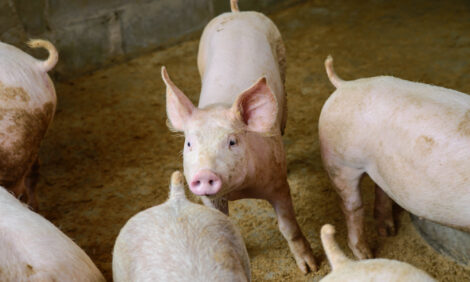



CME: Quarterly Pig, Hogs Report to be Released Friday
US - The USDA will be releasing its quarterly Hogs and Pigs Report on Friday, write Steve Meyer and Len Steiner.That report will be made public at 3:00 p.m. Eastern/2:00
p.m. Central time. The results of DowJones Newswires’ pre-report survey of analysts expectations for the key numbers in Friday’s report appear at right. In spite of the run-up for feed costs this summer, analysts’ expect a “steady-as-she-goes“ report with most numbers very
near 100% of year-ago levels. The only exceptions are the 180 lbs.
and over inventory, farrowing intentions for the next two quarters and
expected litter size for the June-August quarter. This lack of movement
is symptomatic of the pork industry’s limited ability to respond quickly to
cost shifts. It is also attributable, we think, to this cost increase being
the result of a bad weather year whose impact will be more or less
erased if next year’s weather is normal. Maintaining productive capacity through these difficult times may well be handsomely rewarded come
2013. At least for now, producers appear to be doing just that.
Several readers commented on the “pork and bacon
shortage’ story via e-mail today, suggesting that we mention the
potential impact of the EU-wide ban on gestation stalls that goes
into effect January 1, 2013. According to a May 3, 2012 story on
PorkNetwork.com, the UK, Sweden and Luxembourg banned stalls
several years ago and are already 100% compliant with the new regs.
Another twelve EU countries say they will be compliant by January 1
and the remaining 12 are expected to be 70-90% compliant.
The real questions are: “What happens to the pigs on farms
that are not compliant?“ Will farms that still have pigs but are not compliant be allowed to sell them? How many farms will just cease production instead of converting to pen gestation? This last situation caused a
great deal of havoc in France’s egg business this year when a substantial portion of output disappeared quickly, leaving a gaping hole in egg
supplies and sharply higher egg prices for consumers.
The farminguk.com article that launched this “bacon shortage“
fervor did not mention gestation stalls but a policy issue like that is more
likely to cause a rapid change in output than even the short crops that
we have watched develop over several months. EU pork supplies may
fall pretty quickly next year but we — and apparently the analysts responding to DowJones’ survey — do not expect any large or sudden
drops in U.S. pork supplies.
And one more perspective on U.S. hog slaughter and production. The chart at right shows annual figures for slaughter in million head and production in billion pounds carcass weight. It is clear
that the rapid and steady growth of the U.S. pork industry was stopped
well before drought set in late last year and the impact of that drought
became evident this summer. 2008’s large increase in both of these
measures was due to a slight growth in the December 2007 (+2% yr/yr)
and March 2008 (+1% yr/yr) breeding herds, nearly 2% growth in litter
size from mid-2007 onward and HUGE improvements in pig survivability
and growth rate. The last two and, perhaps, the increase in litter size
were primarily caused by circorvirus vaccines .
But it has been pretty much downhill from there with only a
modest increase in both numbers in 2011 and, we think, again this year.
Slaughter is on pace to gain 1% for the year. Weights are 0.4% higher
YTD and that figure will get closer to year-ago levels through Q4 due to
high feed costs. Tto get per capita supplies, you can knock another 1-
1.5% off these numbers to account for growing exports and rising population. The drought is just the latest reason for lower pork availability.









